### Grandics, Peter: (page created at November 2007 update)
## The Genesis of Electromagnetic and Gravitational Forces, Peter Grandics from ‘The Genesis Paper-JNE2002 .pdf’, 357kb, 15 pages.
For reprints, mail requests to Peter Grandics, Ph.D., Atmospheric Electricity Corporation ; P.O.Box 1682 Rancho Santa Fe, CA 92067 ; (e-mail: pgrandics@earthlink.net)
# Abstract:
This paper proposes a new geometrical theory for the formation of subatomic structures underlying electric polarities and gravitation, and describes their interactions at the sub-elemental particle level. The structures are derived from two basic observations and their interpretations. It is observed that spiral motion is a fundamental action of matter and that all material manifestation is a type of crystal. The observed generality of crystalline structures is extended to the so-called vacuum space proposing it to be crystalline. Vacuum space lattice sites are postulated to be populated with fundamental energy vortex particles called Space-Time Array Resonators (STARs). STARs are units of energy tied into a pulsating spiral vortex called a circumvolution cissoid and are the basis for all particles of matter.
The postulated unit cell of the space lattice is a face-centered cube. The space lattice is described as a non-compressible, frictionless fluid comprised of unit cell cubes of energy vortices. Particles of matter arise from the space lattice by absorbing resonant frequencies of electromagnetic radiations. This is exemplified by the formation of the electron and positron, represented by specific vortex structures acting as circulators of the space lattice.
The specific directions of circulating fluid space lattice determine electric polarities. Attraction of free charges is governed by a directional flow of fluid space lattice between the opposite electric poles. A unidirectional flow of space lattice also occurs between separated positive and negative charges, causing a directional motion of the charged object (e.g., an electric condenser). This conclusion leads to an inertialess propulsion and gravity cancellation method, which provides the first experimental proof of this theory. Electrostatic and magnetic fields are defined as space lattice currents, which follow specific geometries, and their interactions are explained.
The second experimental proof of the theory is obtained when electrostatic and magnetic fields are superimposed at an angle provided by a pyramidal structure. The interaction causes a space lattice vortex around the pyramid, which can be tapped. This can potentially become the source of an unlimited supply of electric energy.
A pressure differential of the space lattice between two or more interacting material bodies, a large-scale replica of the flow patterns inside the vortex electron, creates the gravitational interaction. All three forces acting at a distance can operate within the same spatial and temporal domain, independent of each other, in full agreement with experimental observation.
# The Theory:
This paper attempts to explain the genesis of two elemental particles, the electron and positron, based on geometric or space relationships, and to describe their interactions at the sub-elemental particle level. The advantage of such an approach is that it can be visualized, and not just expressed mathematically. By definition, the word structure implies a geometric relationship, and such a relationship must be of great importance in atomic structures even though they are hidden from direct view.
The study of geometric relationships of macroscopic structures of matter may provide important insights into the properties of matter at the microscale. Astrophysics suggests the universe probably started with an energy burst from one point. This Big Bang theory is supported by visual and spectroscopic evidence that the galaxies are expanding away from a single center.
In stellar formation, gravitational pull and velocity generate a rotary vortex. Even in the relative absence of such factors, all objects spiral at some given rate peculiar to their special influences. A spiral is created when an object moves forward while rotating.
Earths movement in space is an example of this process. The Earth orbits the sun, while the sun pulls it along towards the direction of Vega in the constellation Hercules. The combined circular and forward motion creates a spiral. Our sun has the same motion in relation to the galaxy center. Our galaxy, the Milky Way, also spirals away from the Big Bang center.
Water going down a drain demonstrates some of the special influences affecting spiral formation. The spiral, caused by Coriolis forces, changes dynamically under the effects of gravitational pull, drain diameter, obstructions, temperature, pressure, volume, viscosity, and stirring. The spiral changes shape and acceleration but maintains the universal shape of a spiral. The water flow is responsive to all possible factors, and so is the spiral.
Remarkably, the spiral vortex has a memory of itself. When a vortex is distorted into an ellipse, it spontaneously returns to its original circular form when the distorting influence ends. The vortex is a self-sustaining type of motion; its resiliency is comparable to that of atomic bodies.
Spirals condense energy and sine waves transmit it along a frictional line of force between them (Fig.1). Spirals and waves could be considered complementary aspects of each other. Two opposed spirals form a wave, or a wave produces two spirals. A sine is the producer of waves of spiral forces. Any fluid capable of supporting wave motion can also support vortex motion.
The spiral is the prominent form of organization of matter. The large proportion of spiral galaxies among celestial bodies visibly demonstrates this. On the microscale, even the building block of life, DNA, uses this structure, and spirals are likely to be dominant at the level of the atom and below. This is the subject of the present theory.
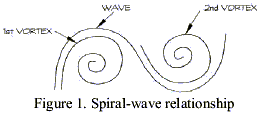
I propose that all atoms and all stellar formations use the mutable spiral to adapt to their spiral environment.
Another proposition is that all mediums of matter can be considered a type of crystal. Crystallinity is readily recognizable in the mineral world, but it is also a more general state of matter. By definition, a crystal is a regularly repeating atomic arrangement, such as a chemical element, compound or isomorphous mixture. Besides solid crystals, liquid crystals also exist. Therefore, the term crystal can be applied to material expressions where crystallinity is not obvious, e.g., gases, complex biologics and various life forms, including viruses, bacteria and higher organisms.
Air and water could be considered loose crystals subject to fast molecular drift. At low temperatures where molecular drift is reduced, gases form solid or liquid crystals.
Even helium, the most volatile of all gases, can be crystallized under the appropriate conditions. Soil and stone and metal are opaque cryptocrystals with slower rates of molecular drift. On the macroscale, the Earth could be seen as faceted crystal with its mountain ridges as the ridge of a geodesic sphere. Biopolymers such as DNA, proteins or polysaccharides fit the definition of a crystal and are commonly made into crystals for analysis and other purposes. All life can be seen as a crystal. From fish to humans, we are liquid crystals on a skeletal lattice.
Crystals are the shape of discrete units of matter and notably the channelized direction of energy, that is, the direction in which energy flows unforced. Crystals form the basis for corpuscle-wave conversion. Crystals create resonance and conduct the flow of energy between states. Crystals can also be considered lenses. By definition, a lens is a device capable of refracting, or bending light. Light is an energy flow, so on a more general term, a lens can be defined as any object capable of changing the direction of energy flow. By this broader definition, even an electric wire is a lens, as it is capable of changing the direction of flow of electrical energy. Lenses communicate energy as part of the principle that all matter vibrates, all matter transmits, and all matter receives energy. The universe changes energy states with lenses. Following this line of reasoning, the universe could be viewed as a resonant crystal lens.
This observation is compelling because the universe is considered to be largely empty, the largest component of which is the so-called vacuum space. Since Nature seems to use the same geometrical organizing principles from micro to macro, I suggest that the vacuum space must also be crystalline. Since the term crystalline is associated with material of which the vacuum space is substantially devoid, I will use an extended meaning of structure when discussing the crystallinity of vacuum space.
The theory of crystalline vacuum space was introduced by Simhony (1990, 1994). Simhony reasoned that three-dimensional physical phenomena must have threedimensional physical causes and explanations. He demonstrated that physical reality could be described by the laws of classical physics supplemented by the presence of a space lattice. This led to the development of the theory of an electron-positron lattice space (epola for short). In the epola, bound electron-positron pairs reside at the lattice sites of a face-centered cubical crystal structure similar to that of NaCl crystals (Kennon 1978). The face-centered cube geometry allows the densest packing of spherical particles.
The epola theory allowed a physical explanation of all yet unexplained postulates of quantum mechanics and relativity including the particle-wave duality, the quantized nature of electron orbits in the atom, electromagnetic radiation, the photon, and gravitational interactions as well as the relationship of electrostatic, magnetic and gravitational interactions. Simhony demonstrated gravity to be a derivative of electromagnetism.
There is a large body of evidence suggesting that the vacuum space is not empty at all. Experiments verify that the vacuum space contains an enormous residual background energy (Boyer 1985, Haisch 1994, 1997, 1999, 2000, Rueda 1995, 1999, Matthews 1994, 1995, Casimir 1948, Lamoreux 1997, Sakharov 1968), called zero-point energy (ZPE). The ZPE manifests as a pervasive and vast electromagnetic field called the zero-point field (ZPF) described by Haisch, Rueda and Puthoff (1994). A dynamic field, ZPF is virtual plasma, with particles arising and disappearing of a background energy field serving as a baseline, or zero point, for all physical processes. The ZPE remains even at absolute zero. Simhony has described zero-point energy fluctuations as analogous to
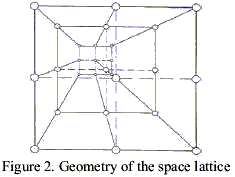
Brownian motion of epola particles around their lattice sites. A potential alternative term for the lattice space is the zero-point-field. This area remains an active field of research.
Simhony also suggested that all particles of matter are formed directly from the lattice space (Simhony 1990), the mechanism of which remains undetermined. The present theory intends to answer this question in terms of lattice space.
I propose that the vacuum space has a lattice structure similar to that introduced by Simhony. This structure is a face-centered cube having 27 lattice sites (Fig. 2). On the lattice sites reside the elemental particles forming all particles of matter. These are particles of energy rather than particles of matter.
I propose that the particle of energy of the space lattice, called here the Space-Time Array Resonator (STAR), is a spiral energy vortex tied into itself in the form of a circumvolution cissoid. The circumvolution cissoid is a spiral turning around an axis converging into an apex, in a self-imploding, self-sustaining vortex motion (Fig. 3). The vortex pulsates and its vibration is a function of (2Piø)x, where ø is the Fibonacci series number and x = 0, 1, 2, 3, the number of turns the circumvolution cissoid makes. Once started up, such a vortex would run practically indefinitely inside the space lattice.
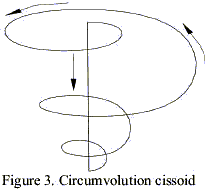
The internal friction of such a space lattice must be so low that it would only be noticeable as a red shift in the spectra of distant galaxies. The space lattice, like its constituent energy vortices, must also be a resilient structure with only limited compressibility. At the same time, it must have fluidity since it is capable of transmitting waves with transverse displacement. In the absence of atomic oscillators, the space lattice would be incapable of dissipating energy in the form of heat.
Vortices maintain their circular forms as well as their proportions and dimensions.
The adjacent vortices have a coordinating effect that establishes axial alignment and rolling contact between vortices within the space lattice. In that sense, there is a great deal of similarity between crystals of material bodies and the structure of the space lattice. I postulate that the space lattice is an incompressible, frictionless fluid made out of unit cells cubes of energy particle vortices. The potential higher order structures of the space lattice will be discussed in a subsequent paper.
We can consider the space lattice equivalent to motion. A space lattice in motion necessarily has inertia. Although inertia is generally attributed to moving material bodies, it is actually a property of motion. Inertia is just the continuity of motion. In the case of vortex motion, the inertia is localized. Localized inertia can also be called momentum. To account for the elemental particles of matter, we just need a space lattice that is capable of moving.
Anderson discovered in 1932 that when 1.02 MeV photon energy is absorbed into the vacuum space, an electron-positron pair may appear. This observation is interpreted here as a glimpse into the formation of elemental particles of matter. To become matter, energy must become more angular. This hypothesis is derived from the observation that all material expression is a type of crystal, and is the compound and derivative of a fundamental triangular shape from which all the seven crystal systems can be derived (Kennon 1978).

The mechanics of this expression at the level of the space lattice are explained as follows: As the energy of electromagnetic radiation propagates through the space lattice, it polarizes the STAR vortices (for analogy see Fig.1). Subsequently, the energy particles of the space lattice undergo a phase transition similar to the condensation of gases. This happens at the resonant frequency of 1.02 MeV gamma radiation.
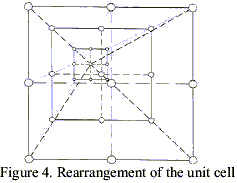
The 27 STAR particles of the unit cell of space lattice rearrange into a pyramidal segment of the cube (Fig. 4) on six levels, forming six circles of vortices. An open-flat presentation of the rearrangement is shown in Figure 5. This structure is the postulated smallest unit of matter. Note that the cube is composed of six interlocking pyramids, making the cube and the pyramid resonant structures. Inside the pyramid, the STAR rings form a vortex capable of circulating the fluid space lattice. The pumping action is driven by the self-sustaining, pulsating vortex motion of its constituent STAR particles (Fig. 3). The overall shape is a cone fitting inside the pyramid. The formation of matter follows the geometry of the space lattice (Fig. 4) and thus we may conclude that the blueprint for matter is built into the space lattice.
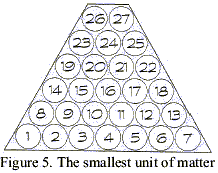
An electron is produced when two cones are joined in a tip-to-tip configuration (Fig. 6). The positron is made out of two vortices (cones) facing base-to-base. The energy vortices that make up the electrons have a resilient vibratory structure, which should be capable of vibrating at various frequencies and modes. This would allow us to account for the series of spectral lines, a signature of energy absorbed and emitted at various frequencies.
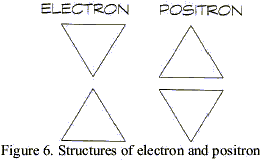
The pumping effect and circulation of the fluid space lattice by these complex vortex particles proceeds as follows: For the electron, the space lattice is drawn in polarly and expelled equatorially; for the positron, the space lattice is drawn in equatorially and expelled polarly (Fig. 7). The direction of the circulation of the fluid space lattice determines the positive or negative polarities. When in close proximity, a specific flow coupling occurs between the electron and positron (Fig. 7). It is quite probable that a similar flow coupling exists between a proton and an electron inside the atom; such a coupling is stable in the case of the proton. This is likely a result of the different vibratory structure of the vortex proton.
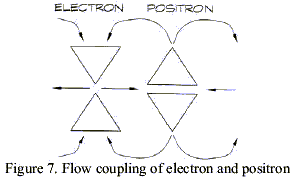
The instability of the electron-positron pair is also derived from this model. The perfectly fitting, counter-rotating cones of energy extinguish each other instantaneously, releasing a combined energy of 1.02 Mev. This results in the reconstitution of the respective unit cells of the space lattice along with the release of the phase transition energy as electromagnetic radiation.
The size of the STAR particle is estimated at 0.005 fm based on the nuclear radius of 0.1 fm for the electron. The lattice constant for the unit cell of the space lattice is approximately half the nuclear radius of the electron, i.e, 0.05 fm. This indicates that the space lattice is quite dense compared to atomic bodies.
The model explains the attraction of free electric charges as follows (Fig. 8). The movement of opposite charges toward each other is due to the equatorial circulation
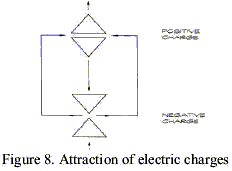
of fluid space lattice from the negative charge to the positive charge and the polar circulation of space lattice from the positive to the negative charge. The attraction of the vortices pulls the two partners together. The electrostatic field between separated charges is defined as the flow of the space lattice from the protons to the electrons and the outside return flow of space lattice from the electrons to the protons. This explanation will eventually lead to a hydromechanical theory of electricity.
Interestingly, there is a net unidirectional flow of fluid space lattice in the axial direction of the free electric charges flowing in at the negative pole and flowing out at the positive pole (Fig. 8). If the charges have a steady parallel orientation, e.g., as in an electric condenser, then a pressure differential must arise in the space lattice around the opposite poles of the condenser. To fully appreciate the significance of this conclusion, one must first examine how material bodies accelerate through the space lattice.
Accelerating objects encounter resistance, facing an increased pressure of the space lattice at the front end and a reduced pressure at the rear end. This situation is common to all propulsion methods that apply a mechanical force on the physical object. It is logical to suggest that a pressure differential of space lattice at the opposite sides of material bodies is always accompanied by a change in the rest or motion of such bodies.
To achieve propulsion, instead of applying force to the physical object we should transfer the space lattice that controls the behavior of the object from the rear end of the object to its front end.
Therefore, a charged electric condenser with its own generated space lattice pressure differential should behave as an accelerating object, i.e., it should move toward the direction of its positive pole. In fact, such an observation was made as early as 1926, the so-called Biefield-Brown Effect (Brown 1928). Biefield and Brown found that a charged electric condenser suspended on a thread moved in the direction of its positive pole. Without a plausible theoretical explanation, the observation received little attention.
However, the Biefield-Brown Effect provides an experimental proof for this theory of electric polarities. Now that the fundamentals are developed, the Effect may provide the basis for a new propulsion and gravity cancellation method, and may give us insights into the mechanism of gravitation. A craft utilizing such a propulsion method could exhibit inertialess acceleration, as it would meet no resistance from the surrounding space lattice.
The theory also allows the development of strategies for tapping into the energy of the space surrounding us. Separated charges in an electric condenser cause a directional flow of the fluid space lattice. Conversely, if we could induce a directional flow of the space lattice, it would cause a separation of charges in material objects. To explain how such an effect could be produced, the physical basis of magnetism must first be discussed.
I have described the physical basis for the electrostatic field as an axial flow of a space lattice current from the positive charges to the negative charges and back along the outside to the positive charges. I shall now explain how these space lattice currents flow in an electric wire. The space lattice flow that connects the electrons to the protons of the atoms in the wire becomes extended along the length of the wire. This is the same direction as the direction of movement of electrons that, in the current, flow in the outer shell of the wire. The external return flow of the space lattice proceeds in the opposite direction in the space around the wire. This flow constitutes the magnetic field.
In a solenoid, the surrounding space lattice flows in the opposite direction relative to the path of the electrons. The magnetic effect will appear as either N or S magnetic poles. The magnetic poles are mirror images of each other. This suggests that a single isolated magnetic pole cannot exist.
In the electrostatic field, the outside space lattice current flows between electrically charged particles. The magnetic field, on the other hand, exhibits a closed circuit flow of the space lattice along the path of a solenoid or a circuit. Movement of the space lattice in spirals or whorls produces electric and magnetic forces.
An electric charge and a magnetic pole interact even though they do not apply any force to each other. A magnetic pole will bring about a directional orientation of the electrons in a charged object, while an electric charge will cause the electric polarization of the adjacent surface of a magnetic pole.
The next question concerns the superimposition of electrostatic and magnetic fields on each other. The practical significance of the interaction of axially oriented electrostatic and magnetic fields is likely to be small compared to their interaction at an angle. A transversal superimposition of a magnetic field on an electrostatic field will cause the distortion of both fields. The axial flow of the space lattice between the electric poles (the physical basis for the electrostatic field) will be distorted, but its circulation will continue. Similarly, the rotating space lattice, the basis for the magnetic field, will also be distorted, flowing in irregular circuits.
To study the transverse superimposition of electrostatic and magnetic fields, a shaped electrostatic field must be created (Fig. 9).
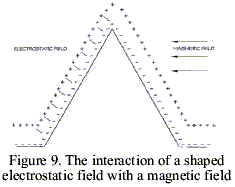
When a magnetic field interacts with the shaped flow of the space lattice, it results in the formation of a space lattice vortex at the points where the two currents intersect. This is based on the previous hypothesis that the space lattice is an incompressible fluid, wherein the intersecting currents cannot penetrate, but distort each others flow patterns.
Expanding this shaped electrostatic field into three dimensions creates a pyramid.
I have already discussed the importance of the pyramidal geometry in the formation of matter. The pyramidal geometry may also be important for producing a space lattice perturbation, the equivalent of a magnetic field following a rotational symmetry (e.g., a vortex).
If transversally superimposed electrostatic and magnetic fields on a pyramid would indeed produce a vortex in the space lattice, then the rotational flow of the space lattice should cause the separation of charges and an electric current in material bodies, as predicted by this theory. Simply stated, the pyramid could convert electrostatic energy into magnetic energy. This means that under appropriate conditions, a pyramid could become a power generator.
For power generation in a pyramid, the source of the electrostatic and magnetic fields could potentially be the Earth. The Earth has a high voltage electric field due to the negatively charged surface covered by the positively charged atmosphere (Feynman 1964). The voltage field, believed to be maintained by the Suns radiation energy and/or cosmic ray energy, extends from the ionosphere to the surface creating a potential difference of about 400,000 V. The Earths electrostatic field is never depleted despite a constant discharge of energy. The Earths electrostatic and magnetic fields could be utilized to create a space lattice vortex in and around a sufficiently sized pyramid that could be tapped. Experimental data supporting this conclusion has recently been reported (Grandics 2000).
Lastly, the gravitational interaction is considered based on the circulation of space lattice currents. As discussed earlier, material bodies spontaneously circulate the space lattice with no specific orientation. In the case of a single spherical body, such as a planet, the space lattice will assume a spherical shape all around the planet, conforming to its spherical symmetry.
This suggests that a bound layer of space lattice surrounds material bodies. The Earth on its orbit around the Sun carries this stationary bound layer along. The gravitational field of the Earth is linked to the gravitational field of the Sun; therefore, the bound layer of space lattice would not follow the rotation of the Earth on its axis.
The gravitational force is generated in the space lattice by interacting material bodies as follows: In the case of two bodies, such as the Sun and Earth, their space lattice currents will organize themselves similarly to the vortex electron (Fig. 7) forming a bipolar vortex, although on a very large scale.
As the space lattice is an incompressible fluid, the currents between the respective bodies cannot penetrate, but deflect each others flows generating outward flows between the objects. To compensate for this outward flow, there must be an equivalent inward flow through the material bodies. This should create a pressure differential such that the space lattice between the bodies will be at a lower pressure than at their remote sides. The pressure differential will push the two bodies toward each other, eventually causing a collision. However, if they are orbiting each other, the centrifugal force will keep them apart.
The flow of space lattice in electric and magnetic fields is always confined to limited regions, that is, it either flows from positive to negative poles or around a closed circuit, whereas the space lattice flow in a gravitational field has no polarity and thus can traverse vast distances, passing through all bodies in its path.
The space lattice theory provides an answer as to how these forces can act independently of each other within the same spatial and temporal domain. Electric and magnetic forces are caused by space lattice currents in the form of spirals or whorls existing independently of a pressure differential in the space lattice. This explains why electric and magnetic force fields can exist and operate irrespective of the gravitational force field, and vice versa.
A large body of evidence demonstrates that electric and magnetic forces can override gravitation. When electromagnetic effects generate a net flow of space lattice with a direction opposing the direction of flow of space lattice between two gravitationally linked objects, the two flows can cancel out each others effects, resulting in the elimination of gravitation. An electric condenser could create such an effect. The fundamentals of this observation are now clarified by this theory.
# Conclusions:
The theory presented here expands upon the lattice space theory introduced by Simhony. Many of the conclusions drawn from Simhonys theory remain in effect in context of the present theory. The space lattice theory allows the development of a fully physical model of reality, and offers a rational basis for tackling elusive physical phenomena, such as gravity or ZPE.
The present theory of electromagnetic and gravitational forces provides a framework for addressing basic properties of matter as well as interactions between material bodies. The theory of a fundamental matrix of the universe (space lattice) leads us to experimentally testable conclusions. The possible outcomes of the theory may include the basis for an inertialess propulsion method and a method for producing electrical energy from the electromagnetic field of the Earth.
The theory of the elementary energy particle of the space lattice, the STAR, leads us further into the mysteries of matter.
I predict that by modulating the vibratory status of the STARs, certain properties of matter could be vastly altered. In ordinary matter, the vibrations of STARs are random. If their vibrations could be synchronized leading to the formation of standing waves, the space lattice pumping action of the elementary particles of matter would be suspended. This could eliminate the physical basis for electromagnetic and gravitational interactions. Gravitation would cease to exist, as well as electromagnetic phenomena. Matter would not interact with electromagnetic radiation, leading to invisibility of matter. This could become the ultimate method of stealth.
Since such an object would not interact with the gravitational or electromagnetic force fields of the Universe, it could be accelerated to velocities in excess of the speed of light. This would open up the avenue for developing interstellar space flight capability.
I further predict, that under certain vibratory conditions, even the dimensions of the atom, the size of the nucleus and the distance of the electrons from the nucleus could be altered. The atom could potentially be expanded or shrunk by modulating the rate at which the fluid space lattice is pumped through the smallest unit of matter (Fig. 4).
All the potential applications of such discoveries are difficult to perceive. An analysis of the potential vibratory modes of the circumvolution cissoid will be presented in a subsequent paper.
The present theory of space lattice establishes a theoretical framework unifying the three fundamental forces acting a distance. The new physics will allow us to probe into previously unreachable domains of nature.
In summary, this paper offers the following conclusions:
1. All expressions of matter are organized into geometrical structures called crystals, a feature shared by the so-called vacuum space.
2. The basic unit of vacuum space is a particle of energy called the space-time array resonator (STAR).
3. The unit cell of vacuum space is a face-centered cube having 27 STARs at its lattice sites.
4. Matter originates from the space lattice by the absorption of radiation at certain frequencies. For the electron and positron, this frequency is the frequency of 1.02 MeV electromagnetic radiation.
5. Matter arises in a pyramidal segment of the space lattice by a phase transition of the 27 STARs of the unit cell.
6. The reversal of this process reconstitutes the space lattice.
7. All particles of matter are energy spirals tied into a circumvolution cissoid.
8. All particles of matter are STAR compounds.
9. Energy is expressed in the geometrical form of a spiral, while matter is organized around the structures of spiral and pyramid and the compounds and derivatives thereof.
10. The polarities of electric charges are established by the specific circulatory patterns of the elemental energy particles of matter.
11. The rest or motion of material bodies can be altered by creating a pressure differential in the space lattice on the opposite sides of such bodies. An electric condenser is capable of creating such a pressure differential, which could lead to an inertialess propulsion method.
12. Electrostatic and magnetic fields represent space lattice currents of specific geometries.
13. Transversally superimposed electrostatic and magnetic fields cause a space lattice vortex in a pyramid, the energy of which could be tapped.
14. Gravitational interaction is created by a pressure differential of the space lattice between two or more interacting material bodies, which is a large-scale replica of the space lattice flow pattern inside the vortex electron.
15. All three forces acting at a distance can operate within the same spatial and temporal domain, independent of each other, in full agreement with experimental observations.
# Acknowledgement:
I thank Dr. Dietmar Rothe and Gregory M. Vogel for their thoughtful comments on the manuscript.
# References:
– Boyer, T.H. (1985) The classical vacuum (zero-point energy) Scientific American 70-78.
– Brown, T.T. (1928) A method of and an apparatus or machine for producing force or motion, US Patent No. 300,311.
– Casimir, H.G.B. (1948) On the attraction between two perfectly conducting plates, Proc.
– Kon. Ned. Akad. van Weten., 51, No. 7, 793-796.
– Feynman, R.P. (1964) Lectures on Physics, v. 2, 9, Addison-Wesley, Inc., Palo Alto, California.
– Grandics, P. A method to capture atmospheric electrostatic energy, in Proceedings of IEJ-ESA Joint Symposium on Electrostatics, Kyoto University, Kyoto, Japan, pp. 355- 361 (2000).
– Haisch, B., Rueda, A. and Puthoff, H.E. (1994) Beyond E=mc2, The Sciences, 34, No. 6, 26-31.
– Haisch, B., Rueda, A. and Puthoff, H.E. (1997) Physics of the zero-point-field: Implications for inertia, gravitation and mass, Speculations in Science & Technology, 20, 99-114.
– Haisch, B. and Rueda A, (1999) Progress in establishing a connection between the electromagnetic zero-point field and inertia, Space Technology and Applications International Forum-99, American Institute of Physics Conference Proceedings 458,
– Mohammed S. El-Genk, ed., p. 988.
– Haisch, B. and Rueda A., (2000) On the relation between zero-point-field-induced inertial mass and the Einstein-de Broglie formula, Physics Letters A, 268, 224.
– Kennon, N.F. (1978) Patterns in Crystals, John Wiley & Sons, New York.
– Lamoreaux, S.K. (1997) Demonstration of the Casimir force in the 0.6 to 6 mm range, Phys. Rev. Lett., 78, No.1, 5-8.
– Matthews, R. (1994) Inertia: Does empty space put up the resistance? Science, 263, 612- 613.
– Matthews, R. (1995). Nothing like a vacuum, New Scientist, 25 February
– Rueda, A., Haisch, B. and Cole, D.C. (1995) Vacuum zero-point field pressure instability in astrophysical plasmas and the formation of cosmic voids, Astrophys. J., 445, 7-16.
– Rueda A, Sunahata, H. and Haisch B., (1999) Electromagnetic zero point field as active energy source in the intergalactic medium, 35th AIAA/ASME/SAE/ASEE AIAA Joint Propulsion Conference, AIAA paper 99-2145.
– Sakharov, A. (1968) Vacuum quantum fluctuations in curved space and the theory of gravitation, Sov. Phys.-Dokl., 12, No. 11, 1040-1041.
– Simhony, M. (1990) The Electron-Positron Lattice Space, Cause of Relativity and Quantum Effects, Physics Section 5, The Hebrew University, Jerusalem.
– Simhony, M. (1994) Invitation to the Natural Physics of Matter, Space, and Radiation, World Scientific Publishing Co., London, UK.
## Peter GRANDICS, Pyramid Electrical Generator, from http://rexresearch.com/grandics/grandics.htm
# Detailed technical explanation with experiments: Infinite Energy, Vol. 13, Issue 73 (2007): Pyramidal Electric Transducer: A DC to RF Converter for the Capture of Atmospheric Electrostatic Energy
Video: http://panacea-bocaf.org/files/patrickkelly/pyramid.asf (44 MB) — Must-see mind-boggling.
# USP 6,974,110 ; December 13, 2005 ; Method and Apparatus for Converting Electrostatic Potential Energy
Abstract : A new method is described to produce useful electrical energy from DC electrostatic fields using a pyramid-shaped capacitor. The system uses no moving parts and no mechanical energy is introduced. Also, when a pyramid-shaped electrode is charged with DC high voltage, a propulsive force is generated. This will allow the manufacture of vehicles capable of levitation and flight.
Current U.S. Class: 244/171.5 ; 244/62; Current International Class: F03H 005/00 (); Field of Search: 244/172,158R,169,62,53R,51
References Cited:
U.S. Patent Documents:
– 3013201 December 1961 Goldie
– 4127804 November 1978 Breaux
– 4151409 April 1979 O’Hare
– 4595852 June 1986 Gundlach
– 5052638 October 1991 Minovitch
– 5305974 April 1994 Willis
– 5813217 September 1998 Beall
– 5947421 September 1999 Beattie et al.
– 5966986 October 1999 Laul
– 6089511 July 2000 Rasmusson
– 6193194 February 2001 Minovitch
Other References :
– DC Circuits vol. II, Circuit Analysis Methods, 1979. .
– Engineering Circuit Analysis, Third Edition, 1978. .
– R.V. Anderson, in Electrical Processes in Atmospheres, (H. Holezalek & R. Reiter, eds, Steinkopff, Darmstadt, 1977), pp. 87-99. .
– R.G. Roble & I. Tzur, in The Earth’s Electrical Environment, Studies in Geophysics (National Academy Press, Washington, D.C. 1986), pp. 206-231. .
– R.P. Feynman, Lectures on Physics (Addison-Wesley, Inc., Palo Alto, California, 1964), v.2, ch. 9, pp. 1-11. .
– W. Gringel, J.M. Rosen, & D.I. Hofmann, in The Earth’s Electrical Environment, Studies in Geophysics (National Academy Press, Washington, D.C. 1986), pp. 166-182. .
– R.H. Holzworth et al., “Direct Measurement of Lower Atmospheric Vertical Potential Differences,” Geophys. Res. Lett. 8: 783-786 (1981). .
– R.H. Holzworth, “Hy-wire Measurement of Atmospheric Potential,” J. Geophys. Res. 89: 1395-1401 (1984). .
– R.E. Orville, in The Earth’s Electrical Environment, Studies in Geophysics (National Academy Press, Washington, D.C. 1986), pp. 23-29. .
– R.B. Standler & W.P. Winn, “Effects of Coronae on Electrid Fields Beneath Thunderstorms,” Quart. J.R. Met. Soc. 105: 285-302 (1979)..
BACKGROUND OF THE INVENTION : This invention relates to the generation of electrical power by drawing energy from an electrostatic potential field. The conversion of DC electrostatic energy into useable electrical energy by electrostatic generators is already described in the prior art as disclosed in U.S. Pat. Nos. 3,013,201, 4,127,804, 4,151,409 and 4,595,852. Generally, such prior art electrostatic generators utilize mechanical energy to separate charges and thus contain complex mechanics that is difficult to scale up for a high output system. Therefore, the present invention aims to provide an electrostatic generator in which electrical power is derived exclusively from the energy of DC electrostatic fields without the input of mechanical power.
SUMMARY OF THE INVENTION : Pursuant to this invention a simple technique is described to convert the energy of a DC electrostatic field into an alternating current by wrapping a coil around the pyramid. The resulting AC current can be rectified and used for practical purposes. A pyramid-shaped capacitor can also be used in an inverse mode of operation for the generation of propulsive force.
Accordingly, one embodiment of the present invention is a method for converting DC electrostatic energy into usable electrical energy, the method comprising the steps of:
(1) providing a capacitor of pyramidal shape;
(2) placing an insulated coil on the surface of the capacitor, the coil having leads;
(3) attaching a rectifier to the leads of the coil, the rectifier having leads; and
(4) attaching a capacitor or a battery to the leads of the rectifier so that DC electrostatic energy is converted into usable electrical energy.
Another embodiment of the present invention comprises a method for converting DC electrostatic energy into propulsive force comprising the steps of:
(1) providing a first capacitor of pyramidal shape;
(2) placing an insulated conductive tip on the point of the capacitor;
(3) providing a static generator for charging the capacitor, and
(4) attaching 3 ball-shaped smaller capacitors to the bottom of the pyramidal-shaped capacitor; and
(5) providing means to extend or retract the ball-shaped capacitors from the pyramidal-shaped capacitor, so DC electrostatic energy is converted into propulsive force by the action of the first capacitor and the 3 ball-shaped smaller capacitors provide directional control.
BRIEF DESCRIPTION OF THE DRAWINGS : The following invention will become better understood with reference to the specification, appended claims, and accompanying drawings, where:
FIG. 1 is a diagram demonstrating the pyramid experimental setup;
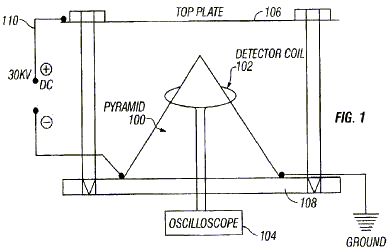
FIG. 2 is the pyramid coil signal as detected by oscilloscope; and
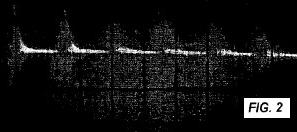
FIG. 3 is a diagram demonstrating power transmission on the pyramid setup.
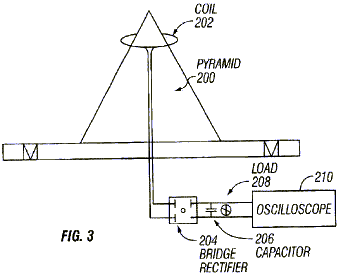
DESCRIPTION OF THE PREFERRED EMBODIMENT : Pursuant to this invention, a novel method is described to convert DC electrostatic energy into an AC current that can be rectified and used for practical purposes. The shape of the capacitor and the body of such device is designed to convert the DC electrostatic energy into the AC current for maximal effect.
A pyramidal or conical shape is preferred for one of the capacitor electrodes (FIG. 1). In FIG. 1, a detector coil 102 is provided that is in turn connected to an oscilloscope 104. The coil surrounds the metallic pyramid 100. In the experimental setup shown, the field is established between a top plate 106 and the pyramid 100 by using a ground 108 connected to a source of DC electrical energy 110. When a high voltage DC field (30 kV) is established on such capacitor, a regularly repeating, clocklike signal is detected in the coil placed on the pyramid’s surface (FIG. 2). This is an unexpected observation as corona discharges are irregular by nature.
The alternating current from the coil can be rectified and used for practical purposes. If a suitable DC electrostatic field could be found in nature, this principle would be useful in tapping the energy of such field. To test for this possibility, I have measured the rectified signal from the coil without an external power source. The rectified coil output was collected in a capacitor and voltage measured in 1 h intervals. The voltage measured is significantly higher if the capacitor electrode is pyramid-shaped as opposed to a box-shaped electrode of the same height and volume. When the pyramid is placed into a Faraday cage, the signal is abolished (see details in the Example). The data has demonstrated in principle that with this experimental setup electrical energy can be extracted from the Earth’s electrostatic field. The Earth’s surface and the ionosphere substitutes for the two charged electrodes, which exhibit negative and positive polarities, respectively.
Atmospheric electricity manifests as a buildup of electrostatic energy, a phenomenon that permanently electrifies our environment (Anderson, R. V. in Electrical Processes in Atmospheres, H. Holezalek and R. Reiter, eds., (Steinkopff, Darmstadt, 1977) pp. 87-99). The voltage gradient between the Earth’s surface and the ionosphere is thought to be maintained by the electrical activity of the troposphere as well as the solar wind-coupled magnetospheric dynamo (Roble, R. G. Tzur, I. in The Earth’s Electrical Environment, Studies in Geophysics (National Academy Press, Washington D.C., 1986) pp. 206-231). The Earth’s electrostatic field is never depleted, despite the constant discharges of energy. There are two segments of atmospheric electrical processes that potentially could be tapped, fair weather and thunderstorm related atmospheric electrical phenomena.
The Earth’s voltage field creates a potential difference of about 400,000 V (Feynman, R. P. Lectures on Physics (Addison Wesley, Inc., Palo Alto, Calif., 1964) v.2, Chapter 9), with a voltage gradient of about 200-300 V/m around the surface of the Earth (W. Gringell, J. M. Rosen, D. I. Hofmann, in The Earth’s Electrical Environment, Studies in Geophysics (National Academy Press, Washington D.C., 1986) pp. 166-182). Given this voltage drop of 200-300 V/m, the desired 30 kV potential can be obtained at a pyramid height of about 100-150 m.
Due to the evolving nature of our understanding of atmospheric electrical processes, we do not have a clear picture of the magnitude of electrical energy generated (and dissipated) in the global atmospheric electrical circuit by localized convective phenomena. Direct measurement of the atmospheric vertical potential difference using tethered balloons have shown that under fair weather conditions and at low altitudes (150-550 m), short circuit currents on the order of 10 .mu.A were obtained with a single wire collector yielding a power of about 1 W (Holzworth, R. H. et al., Direct measurement of lower atmospheric vertical potential differences, Geophys. Res. Lett. 8, 783-786 (1981), and Holzworth, R. H. Hy-wire measurement of atmospheric potential, J. Geophys. Res. 89, 1395-1401 (1984)).
These data remarkably demonstrated that it is possible to couple to a large portion of the atmosphere and also gave an indirect proof of the presence of a fair weather convective generation process. Since at a low altitude of 1500 m, the entire atmospheric vertical electric potential (400 kV) could be bridged, it may even be possible to couple right into ionospheric electrical processes (Holzworth, R. H. et al., Direct measurement of lower atmospheric vertical potential differences, Geophys. Res. Lett. 8,783-786 (1981)). This would significantly expand the available energy pool for this device.
The other possibility is to tap localized peaks of atmospheric electrical activity arising from thunderstorm activity. The approximate order of magnitude of electrostatic energy generated in the troposphere could be estimated by the amount of energy dissipated by lightning discharges. The estimates for the total number of lightning strikes over the entire surface of the Earth vary from 100 to 300 per second (Orville, R. E. in The Earth’s Electrical Environment, Studies in Geophysics (National Academy Press. Washington D.C., 1986) pp. 23-29). The estimate for the power discharged in an average lightning event is 10.sup.12 watts over a time period of about 0.2 sec (Christian, H. J. and McCook, M. A. in A lightning primer at http://thunder.msfc.nasa.gov/). This yields a total of 2-6.times.10.sup.13 W-sec of electrical energy spent by lightning discharges globally in each second, or approximately 4.times.10.sup.17 W-h per year. Over 90% of all lightning occur over landmasses. The distribution of tropospheric electrical activity is highly concentrated, the major production zones being Central Africa, the south central United States and the Amazon Basin (Miller, T. L. Global lighting activity at http://www.ghcc.msfc.nasa.gov/rotating/otd_oval_full.html). This suggests that the density of atmospheric electrical activity in these zones may be high enough to tap.
The current annual global electricity production by the world’s power generating industry is 1,22.times.10.sup.16 W-h (Seth, A. Nuclear power and its role in global electricity and energy, Institute for Energy and Environmental Research, at http://www.ieer.org/ensec/no-1/glbnrg.html (1997)) which is only a small fraction, about 1/30th, of the electricity generated and discharged naturally by lightning activity. As lightning represents only peak charge density events, the localized total charge production of thunderstorms is necessarily underestimated by a factor, the magnitude of which is still unknown.
These indicate that atmospheric electricity, if harnessed, could meet all the energy needs of mankind. This invention describes a new electrical phenomenon that allows the conversion of electrostatic energy into an alternating current.
Research on the average electrical power generated and dissipated by the Earth’s global electrical circuit suggests that about 2000 thunderstorms are in progress at any given time, and that the average storm current delivered to the ionosphere is of the order of one ampere (Roble, R. G. Tzur, I. in The Earth’s Electrical Environment, Studies in Geophysics (National Academy Press, Washington D.C., 1986) pp. 206-231). The potential difference between the Earth and the ionosphere is of the order of 500 kV; therefore, the total source power is of the order 2000.times.1.times.5.times.10.sup.5, or 10.sub.9 watts over the entire planet. Thunderstorms produce an average of one to several nanoamperes per square meter at the surface (Standler, R. B. and Winn, W. P. Quart. J. Met. Soc. 105 285 (1979)). These estimates would suggest that there might not be sufficient energy to tap.
However, the limitation of these low, average Earth surface current densities is not applicable to the pyramid collector for several reasons. In thunderstorms, terawatts of electrical power are generated over relatively long periods of time. To capture this electric power and prevent its dissipation, an effective “charge sink” is necessary. The sub-optimal geometry of the Earth’s surface terrain and its relatively low conductivity produce an ineffective sink which leads to small ground surface current densities. A metal pyramid, however, due to its optimal geometry and construction acts as an effective charge sink.
FIG. 3 shows power transmission on the pyramid setup. In FIG. 3, a pyramid 200 as described above is in contact with a coil 202 and a bridge rectifier 204. The latter is charging capacitor 206 which feeds load 208. Oscilloscope 210 measures the voltage drop on the load.
Accordingly, one embodiment of the invention is a method for converting DC electrostatic energy into usable electrical energy, the method comprising the steps of:
(1) providing a capacitor of pyramidal shape;
(2) placing an insulated coil on the surface of the capacitor, the coil having leads;
(3) attaching a rectifier to the leads of the coil, the rectifier having leads; and
(4) attaching a capacitor or a battery to the leads of the rectifier so that DC electrostatic energy is converted into usable electrical energy.
As detailed below, typically, a clock-like signal is detected from the leads of the coil. The signal can be rectified, pooled in a capacitor, or pooled in a battery.
A production pyramid, with a projected 40,000 m.sup.2 base surface area, a height of 150 m, and a metallic composition would provide a far more effective charge sink than the surrounding ground surface. As current always flows in the direction of least resistance, this would lead to a concentrated flow of current from the thunderclouds into the pyramid. As a result, a column of air above the surface of the pyramid would become highly ionized and much more conductive than the air in the surrounding area. This would ensure a rapid transfer of charges from the thunderclouds into the pyramid. Therefore, the current flowing into the pyramid would likely be very strong. As a result, lightning activity could be reduced or abolished. In addition, since the threshold effect causes exponential power amplification, such a pyramid could produce very large quantities of electrical energy.
The generation of thunderstorm-related electrical energy in the atmosphere shows a high degree of concentration into three major geographical zones (Miller, T. L. Global lightning activity at http://www.ghcc.msfc.nasa.gov/rotating/otd_oval_full.html). By placing energy-producing pyramids into these zones of high-energy electrical activity, vast quantities of electricity could be obtained. Atmospheric electricity would be a renewable, clean energy source, and could give us the opportunity to begin reversing the process of global warming caused by anthropogenic greenhouse gas emissions. This process, which now produces well-measurable results, threatens to upset our ecosystem with unpredictable consequences (Kerr, R. A. Science 286 1828 (1999)).
Electrostatic energy could also be used to produce a propulsive force. A capacitor made into the shape of a pyramid or cone is suitable. The conductive elements of the capacitor are layered into the pyramidal or conical segment of the hull of such craft. Optimally, there should be several layers of negatively charged conductors on the outside while a single layer of positively charged conductor is in the inside of the craft. All conductive elements should be carefully insulated in order to maintain the charges inside the capacitor.
In the center of the craft, a conductive, insulated pole is mounted such that the pole extends out into the exterior at the top of the craft. The tip of that pole has a metal ball mounted on which is also positively charged. When all capacitor plates are charged, a pressure differential is induced and above the craft the pressure will be higher than at the bottom of the craft. This pressure differential is unstable and progresses towards an equilibrium. It will propel the craft forward in order to eliminate the pressure gradient. This requires that a sufficiently high voltage (>100,000 V) be applied. The capacitors incorporated into the hull will give control over the lift.
To obtain directional control over all three axes of movement, three capacitors need to be mounted at the bottom of the craft placed 120.degree. apart from each other. These capacitors could take the shape of a ball and would be mounted on retractable shafts. The top half of the capacitors would be positively charged while the bottom half is negatively charged. When in flight, the capacitors are retracted and charged based on the needs of directional control so that the ball-shaped capacitors provide lateral movement control for the vehicle. To achieve forward movement, the charges on one capacitor facing the direction of the desired path should be reduced relative to the other two capacitors. This would make the craft tilt forward and start moving in that direction. An alternative method of lateral directional control could be obtained by dividing the capacitor bank inside the hull into segments which segments would be charged individually.
Upon landing, the three ball capacitors would be protracted on their shafts and serve as landing gear. On landing, they would be discharged because the earth is the greater ground. On launching, the main capacitors of the hull would be activated leading to takeoff. The three-capacitor landing gear would then be retracted and charged up so that they can function for lateral directional control after takeoff. On-board static generators would supply voltage required for the operation of the craft.
Accordingly, another embodiment of the invention comprises a method for converting DC electrostatic energy into propulsive force comprising the steps of:
(1) providing a first capacitor of pyramidal shape;
(2) placing an insulated conductive tip on the point of the capacitor;
(3) providing a static generator for charging the capacitor, and
(4) attaching 3 ball-shaped smaller capacitors to the bottom of the pyramidal-shaped capacitor; and
(5) providing means to extend or retract the ball-shaped capacitors from the pyramidal-shaped capacitor, so DC electrostatic energy is converted into propulsive force by the action of the first capacitor and the 3 ball-shaped smaller capacitors provide directional control.
Inertial forces pose great obstacles to improving the performance of current propulsion systems. The most significant aspect of this type of propulsion would be the loss of inertia during acceleration. The passengers of such craft would feel no forces acting upon their bodies even if the craft achieved enormous accelerations.
This overall design is suitable for the development of a wide range of transportation vehicles, from automobile-type to aircraft and potentially to spacecraft. With such technology, we could eliminate a major factor in environmental pollution which place a great stress on our ecosystem. In the United States, transportation vehicles produce 66% of the greenhouse gases.
The subject invention offers a solution by providing a renewable, non-polluting electricity generation method as well as an electricity-based transportation method capable of levitation and flight.
The following Example illustrates the features and advantages of the subject invention. Accordingly, it is to be understood that the description in this disclosure is to facilitate comprehension of the invention and should not be construed to limit the scope thereof as persons skilled in the art can, in light of this disclosure, generate additional embodiments without exceeding the scope or departing from the spirit of the claimed invention.
EXAMPLE 1
Demonstration of the pyramid generator: For the experiments, I have selected a one-foot base length foam pyramid from a pyramid vendor (The Pyramid Project, Ft. Wayne, Ind.). The outside of the pyramid was covered with aluminum foil. The pyramid was placed on a 2′.times.2’insulating polyethylene platform equipped with an adjustable height 2′.times.2’size aluminum top plate, 1/16″ thick. The height of the aluminum plate was adjusted as needed and a gap of 1 1/4″ between the plate and the tip of the pyramid was used in the experiments. In some experiments, an aluminum pyramid was used with a wall thickness of 1/16″.
A high voltage (HV) CRT power source producing 30 kV DC was taken from a color monitor. I have assumed that an actual energy-producing pyramid should be relatively high in order to obtain a large voltage drop from its tip to the ground. Therefore, assuming a height of 100-150 m for a life-size pyramid and a voltage drop of 200-300 V/m near the surface of the Earth, the 30 kV is in the range of the voltage-drop expected for the height of a life size pyramid.
The positive pole was attached to the top aluminum plate. This simulated the positive charge of the atmosphere. One corner of the pyramid was attached to the negative pole of the high voltage power source, while the opposite corner of the pyramid was grounded. This setup served as a model for the electrostatic field distribution around a potential life-sized pyramid. As controls, either a 1′.times.1′ sheet of aluminum foil or an aluminum foil-covered box, having the main dimensions of the test pyramid (1′.times.1′.times.7 5/8″), was used as a negative pole. The detector coils were made by winding up a 24 gauge enamel-coated magnet wire (20 turns, approximately 8 cm in diameter). A Tektronix high-frequency oscilloscope, Model no. 2236 was used for signal acquisition and analysis.
The first sets of experiments were control measurements with a box of the same height and base length as the test pyramid. The detector coil was placed on the top of the box. Measurements were taken with or without the high voltage applied. One corner of the box was attached to the HV power source (negative pole) and the opposite corner to the ground. The same arrangement was used for the flat square (1′.times.1′) foil. The peak-to-peak signal amplitude for the box was 8 mV and the signal frequency was 2 MHz. For the flat foil sheet, the signal amplitude was 12 mV with a frequency of 1.43 MHz. The signal form was of a decaying sine wave.
When high voltage was applied to these shapes, signal amplitude of 14 mV was obtained for the flat sheet and of 16 mV for the box. The signal frequency was 1.54 MHz for the flat sheet and 2 MHz for the box. The waveforms were of decaying sine waves in all these experiments.
When the pyramid was tested without HV, the peak-to-peak signal amplitude was measured at 60 mV with a frequency of 2 MHz. When the high voltage was applied, the signal amplitude increased up to 180-200 mV, while the frequency remained at 2 MHz. The pyramid produced signal intensity significantly higher than the controls. The signal is regularly repeating, clock-like in nature (FIG. 2). When a metal (aluminum) pyramid of the same size (wall thickness 1/16″ inch) was tested in the same high voltage field using the same detection coil, a voltage of 1-1.5 V was detected at the frequency of 2 MHz.
To collect energy from the coil, a bridge rectifier (1000 V peak voltage at 6 A) was attached to the leads of the coil. The rectified current was fed into a capacitor (1500 .mu.F, 250 V DC max.), and a direct current of 45 V was obtained. This has demonstrated a simple method to convert electrostatic energy into a continuous direct current. An 8-turn coil having an output of 200-300 V AC (peak-to-peak) was also used for energy conversion. The rectified current from the 8-turn coil powered a 0.186 W light bulb (FIG. 3). The bridge rectifier is optimally made of fast-recovery diodes.
Even in the absence of an externally applied voltage, current is always present in the circuit. Charge builds up in the capacitor and 1 V was obtained overnight using the 20-turn coil setup. Over 48 h, a voltage of 5 V was measured. Faraday shielding practically abolished the phenomenon.
The preferred shape of the pyramid as a charge collector was again demonstrated in further experiments using the 8-turn coil-bridge rectifier-capacitor (1,500 .mu.F) assembly placed on the 1 ft base length aluminum pyramid. A same volume and height aluminum box was used as control. Charging times of 1-2 h were used under fair weather conditions. For the pyramid, 550 mV was measured on the capacitor while on the box 100 mV was obtained. This demonstrated the superiority of the pyramidal shape in capturing atmospheric electrostatic energy. It also demonstrated that we could tap into the electrostatic field of the atmosphere and draw electric energy. For the collection of energy, a battery could substitute for the capacitor.